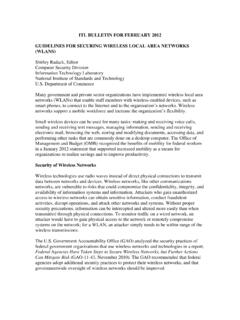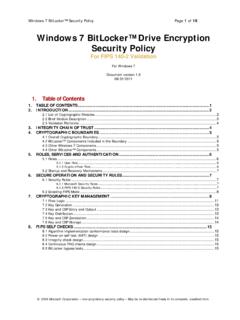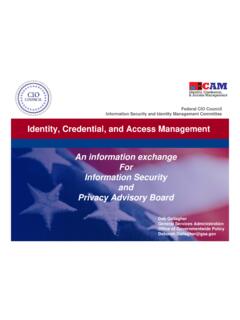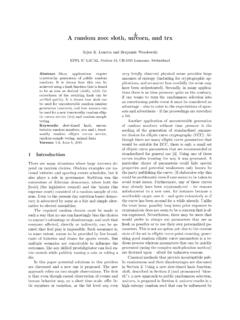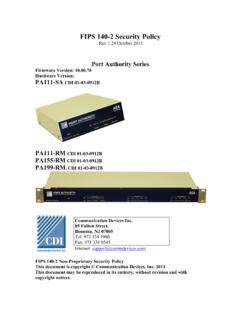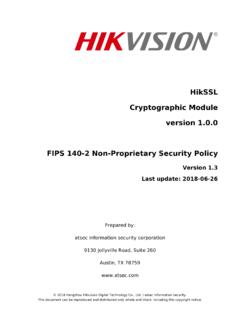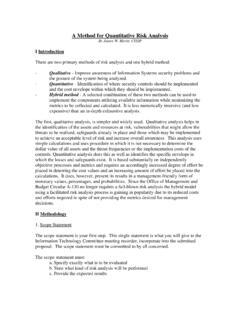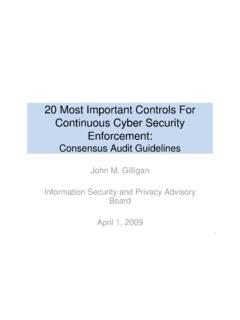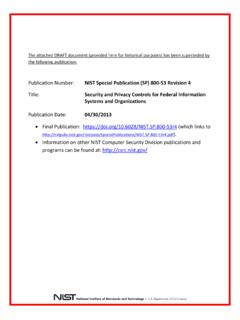Transcription of FIPS 46-3, Data Encryption Standard (DES ... - NIST
1 ARCHIVED PUBLICATION The attached publication, FIPS Publication 46-3 (reaffirmed October 25, 1999), was withdrawn on May 19, 2005 and is provided here only for historical purposes. For related information, see: Special Publication 800- 131a , Transitions: Recommendations for Transitioning the Use of Cryptographic Algorithms and Key Lengths, #800- 131a ; Special Publication 800-67 Rev. 1, Recommendation for the Triple data Encryption Algorithm (TDEA) Block Cipher, #800-67; FIPS Publication 197, Advanced Encryption Standard , #197; and NIST Cryptographic Toolkit: Block Ciphers, FIPS PUB 46-3 FEDERAL INFORMATION PROCESSING standards PUBLICATION Reaffirmed 1999 October 25 DEPARTMENT OF COMMERCE/National Institute of standards and Technology data Encryption Standard (DES) CATEGORY: COMPUTER SECURITY SUBCATEGORY: CRYPTOGRAPHY DEPARTMENT OF COMMERCE, William M.
2 Daley, Secretary NATIONAL INSTITUTE OF standards AND TECHNOLOGY, Raymond G. Kammer, Director Foreword The Federal Information Processing standards Publication Series of the National Institute of standards and Technology (NIST) is the official series of publications relating to standards and guidelines adopted and promulgated under the provisions of Section 5131 of the Information Technology Management Reform Act of 1996 (Public Law 104-106), and the Computer Security Act of 1987 (Public Law 100-235). These mandates have given the Secretary of Commerce and NIST important responsibilities for improving the utilization and management of computer and related telecommunications systems in the Federal Government.
3 The NIST, through its Information Technology Laboratory, provides leadership, technical guidance , and coordination of Government efforts in the development of standards and guidelines in these areas. Comments concerning Federal Information Processing standards Publications are welcomed and should be addressed to the Director, Information Technology Laboratory, National Institute of standards and Technology, 100 Bureau Dr. Stop 8900, Gaithersburg, MD 20899-8900. William Mehuron, Director Information Technology Laboratory Abstract The selective application of technological and related procedural safeguards is an important responsibility of every Federal organization in providing adequate security to its electronic data systems.
4 This publication specifies two cryptographic algorithms, the data Encryption Standard (DES) and the Triple data Encryption Algorithm (TDEA) which may be used by Federal organizations to protect sensitive data . Protection of data during transmission or while in storage may be necessary to maintain the confidentiality and integrity of the information represented by the data . The algorithms uniquely define the mathematical steps required to transform data into a cryptographic cipher and also to transform the cipher back to the original form. The data Encryption Standard is being made available for use by Federal agencies within the context of a total security program consisting of physical security procedures, good information management practices, and computer system/network access controls.
5 This revision supersedes FIPS 46-2 in its entirety. 2 Key words: computer security, data Encryption Standard , triple data Encryption algorithm, Federal Information Processing Standard (FIPS); security. 3 Federal Information Processing standards Publication 46-3 1999 October 25 Announcing the data Encryption Standard Federal Information Processing standards Publications (FIPS PUBS) are issued by the National Institute of standards and Technology after approval by the Secretary of Commerce pursuant to Section 5131 of the Information Technology Management Reform Act of 1996 (Public Law 104 106), and the Computer Security Act of 1987 (Public Law 100-235).
6 1. Name of Standard . data Encryption Standard (DES). 2. Category of Standard . Computer Security, Cryptography. 3. Explanation. The data Encryption Standard (DES) specifies two FIPS approved cryptographic algorithms as required by FIPS 140-1. When used in conjunction with American National standards Institute (ANSI) Standard , this publication provides a complete description of the mathematical algorithms for encrypting (enciphering) and decrypting (deciphering) binary coded information. Encrypting data converts it to an unintelligible form called cipher. Decrypting cipher converts the data back to its original form called plaintext.
7 The algorithms described in this Standard specifies both enciphering and deciphering operations which are based on a binary number called a key. A DES key consists of 64 binary digits ("0"s or "1"s) of which 56 bits are randomly generated and used directly by the algorithm. The other 8 bits, which are not used by the algorithm, may be used for error detection. The 8 error detecting bits are set to make the parity of each 8-bit byte of the key odd, , there is an odd number of "1"s in each 8-bit byte1. A TDEA key consists of three DES keys, which is also referred to as a key bundle. Authorized users of encrypted computer data must have the key that was used to encipher the data in order to decrypt it.
8 The Encryption algorithms specified in this Standard are commonly known among those using the Standard . The cryptographic 1 Sometimes keys are generated in an encrypted form. A random 64-bit number is generated and defined to be the cipher formed by the Encryption of a key using a key encrypting key. In this case the parity bits of the encrypted key cannot be set until after the key is decrypted. 1 security of the data depends on the security provided for the key used to encipher and decipher the data . data can be recovered from cipher only by using exactly the same key used to encipher it.
9 Unauthorized recipients of the cipher who know the algorithm but do not have the correct key cannot derive the original data algorithmically. However, it may be feasible to determine the key by a brute force exhaustion attack. Also, anyone who does have the key and the algorithm can easily decipher the cipher and obtain the original data . A Standard algorithm based on a secure key thus provides a basis for exchanging encrypted computer data by issuing the key used to encipher it to those authorized to have the data . data that is considered sensitive by the responsible authority, data that has a high value, or data that represents a high value should be cryptographically protected if it is vulnerable to unauthorized disclosure or undetected modification during transmission or while in storage.
10 A risk analysis should be performed under the direction of a responsible authority to determine potential threats. The costs of providing cryptographic protection using this Standard as well as alternative methods of providing this protection and their respective costs should be projected. A responsible authority then should make a decision, based on these analyses, whether or not to use cryptographic protection and this Standard . 4. Approving Authority. Secretary of Commerce. 5. Maintenance Agency. Department of Commerce, National Institute of standards and Technology, Information Technology Laboratory.
